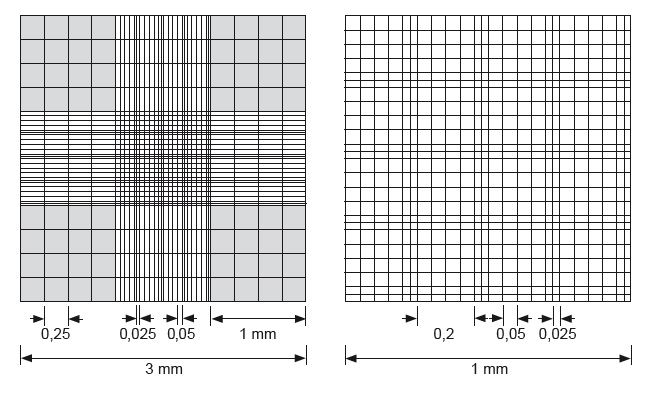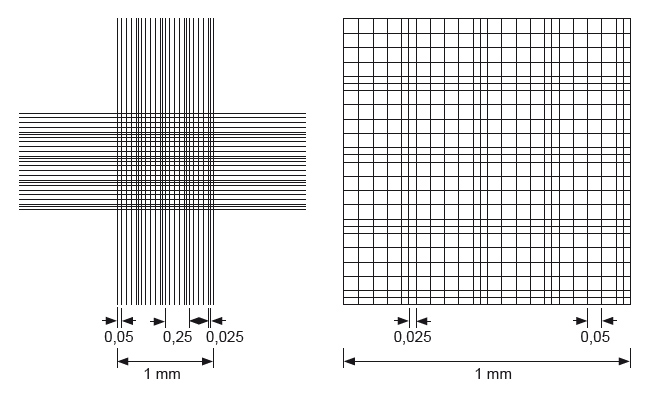Have any questions?
+44 1234 567 890
Counting grids
The types of counting chambers differ in counting grids and the depths of the chambers. Orthogonal lines form grids which become visible by magnifying them with a microscope.
Neubauer-improved
The Neubauer-improved counting chamber has become the most popular one.
Its standard depth is 0.1 mm. The grid consists of 3 x 3 large squares with areas of 1 mm² each. The large square in the center is subdivided into 5 x 5 group squares with edges of 0.2 mm length each. These group squares are again subdivided into sixteen small squares of an area of each 0.05 mm x 0.05 mm = 0.0025 mm².
The lines limiting the large squares and the group squares are threefold with the central line as the actual dimension lines. The inner and outer auxiliary lines facilitate counting. They assist determining whether cells near or on the border lines are to be counted as within the area or omitted as outside of the counting area.
As the counting chamber comes with squares of different sizes it can be used for counting different types of cells. E.g. leucocytes are counted in the 4 large squares at the corners of the grid and for counting erythrocytes at least 5 group squares are normally used.
Dark line:
Under the microscope the lines of the standard counting chambers appear dark.
Bright line:
Counting chambers with bright lines have counting grids which are structured into a very thin, transparent metal coating. The bright lines contrast well with the dark metallic background and this facilitates evaluating cell suspensions.
Neubauer-improved with dark lines

Neubauer-improved with bright lines

| Depth = 0.1 mm | Number squares | mm x mm per square |
sqmm | cmm = µl |
|---|---|---|---|---|
| Total net ruling | 1 | 3 x 3 | 9 | 0.9 |
| Large squares per grid |
9 | 1 x 1 | 1 | 0.1 |
| Group squares per large square |
25 | 0.2 x 0.2 | 0.04 | 0.004 |
| Small squares per group square |
16 | 0.05 x 0.05 | 0.0025 | 0.00025 |
Neubauer
The depth of the Neubauer chamber is 0.1 mm.
Its net ruling covers 3 mm x 3 mm in total and consists of 9 large squares of 1 mm each side length.
The central large square is subdivided in 4 x 4 group squares of 0.2 x 0.2 mm². Triple lines in a distance of 0.025 mm separate the group squares from each other. Each group square is subdivided in 16 small squares of 0.05 mm side length.
Neubauer

| Depth = 0.1 mm | Number squares | mm x mm per square |
sqmm | cmm = µl |
|---|---|---|---|---|
| Total net ruling | 1 | 3 x 3 | 9 | 0.9 |
| Large squares per grid |
9 | 1 x 1 | 1 | 0.1 |
| Group squares per large square |
16 | 0.2 x 0.2 | 0.04 | 0.004 |
| Small squares per group square |
16 | 0.05 x 0.05 | 0.0025 | 0.00025 |
Bürker
The depth of the Buerker counting chamber is 0.1 mm. Its counting grid covers 9 mm² and is subdivided by triple lines into 9 large squares. The distances between the middle lines are 1 mm.
Each of these large squares is subdivided into 16 small squares by double lines with 0.05 mm between them. The inner lines of these small squares form areas of 0.2 x 0.2 mm².
The crossings of the double lines form small squares of 0.05 x 0.05 mm². These squares are suitable for counting thrombocytes and erythrocytes.
Bürker

| Depth = 0.1 mm | Number squares | mm x mm per square |
sqmm | cmm = µl |
|---|---|---|---|---|
| Total net ruling | 1 | 3 x 3 | 9 | 0.9 |
| Large squares per grid |
9 | 1 x 1 | 1 | 0.1 |
| Small squares per large square |
16 | 0.2 x 0.2 | 0.04 | 0.004 |
Bürker-Türk
The depth of the Buerker-Tuerk chamber is 0.1 mm. The counting grid covers 9 mm² and is subdivided by triple lines into 9 large squares.
Each of these large squares is subdivided into 16 small squares by double lines with 0.05 mm between them. The inner lines of these small squares form areas of 0.2 x 0.2 mm².
Additionally to the Buerker chamber the 16 small square of the central large square are subdivided again into 16 squares with 0.05 mm length of the edge and an area of 0.0025 mm².
Bürker-Türk

| Dept = 0.1 mm | Number squares | mm x mm per square |
sqmm | cmm = µl |
|---|---|---|---|---|
| Total net ruling | 1 | 3 x 3 | 9 | 0.9 |
| Large squares per grid |
9 | 1 x 1 | 1 | 0.1 |
| Small squares per large square |
16 | 0.2 x 0.2 | 0.04 | 0.004 |
| Smallest squares per small square |
16 | 0.05 x 0.05 | 0.0025 | 0.00025 |
Fuchs-Rosenthal
The depth of the Fuchs-Rosenthal counting chamber is 0.2 mm. In total the grid covers 16 mm² and contains 16 large squares of 1 mm length of the edge each. These large squares are separated by triple lines with 0.01 mm between each other. The distance between the center lines is 1 mm. All 16 large squares are subdivided into 16 small squares of a side length of 0.25 mm.
Due to the large counting grid and a depth of 0.2 mm the total volume amounts to 3.2 μl. This counting chamber is, therefore, preferably used for counting cell suspensions with relatively few cells, e.g. cerebro-spinal fluid.
Fuchs-Rosenthal

| Depth = 0.2 mm | Number squares | mm x mm per square |
sqmm | cmm = µl |
|---|---|---|---|---|
| Total net ruling | 1 | 4 x 4 | 16 | 3.2 |
| Large squares per grid |
16 | 1 x 1 | 1 | 0.2 |
| Small squares per large square |
16 | 0.25 x 0.25 | 0.0625 | 0.0125 |
Thoma new
The depth of the Thoma new counting chamber is 0.1 mm. The grid covers an area of 1.1 x 1.1 mm². It is subdivided in 16 group squares with a side length of 0.2 mm.
These group squares have a distance of 0.1 mm to the adjacent group squares. They are subdivided into 16 small squares.
Thoma new

Thoma
The depth of the Thoma counting chamber is 0.1 mm The grid covers an area of 1 x 1 mm².
It is subdivided into group squares with a side length of 0.2 mm (like the Neubauer system).
The group squares are subdivided into 16 small squares of an area of 0.05 mm x 0.05 mm = 0.0025 mm².
Thoma

Nageotte
The depth of the Nageotte counting chamber is 0.5 mm.
The square area of 100 mm² is divided into 40 rectangles each with an area of 0.25 x 10 = 2.5 mm².
This counting chamber is mainly used for counting cells in cerebro-spinal fluid or for counting nematodes.
Nageotte

Malassez
The depth of the Malassez counting chamber is 0.2 mm The counting grid covers 2 x 2.5 mm². The large rectangles have an area of 0.25 x 0.20 = 0.05 mm². Each of them is subdivided into 20 small squares with an area of each 0.05 mm x 0.05 mm = 0.0025 mm².
This counting chamber is used for counting cells in liquor (cerebro-spinal fluid) and for counting nematodes for example.
Malassez
